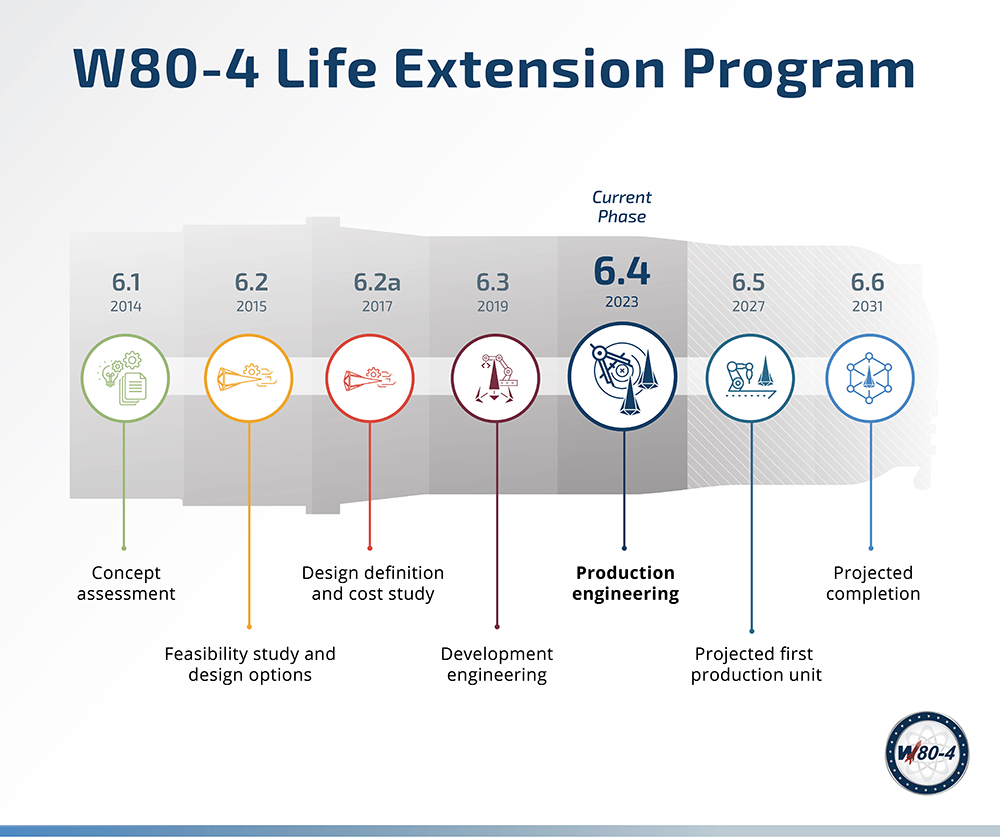
Following NNSA approval earlier this year, the W80-4 Life Extension Program moved into the production engineering phase of the U.S. nuclear weapons life cycle, which will culminate in completion of the program’s first production unit at Pantex in 2027.
Leading up to the production engineering phase, Sandia’s W80-4 team developed requirements and conceptual designs; built test units; down-selected design options; and integrated everything into an overall weapon system, called the baseline design. The flight testing and several other key deliverables demonstrated baseline weapon design performance and enabled the program to advance to the next phase.
As the systems integrator for the W80-4 warhead and design agency for its non-nuclear components, Sandia collaborates closely with other organizations within the Labs and across the U.S. nuclear security enterprise. The W80-4 team partnered with Sandia’s Thermal Test Facility to conduct fuel fire safety tests and with Lawrence Livermore National Laboratory to conduct hydrodynamics tests. The team also conducted joint flight tests with the Air Force and Raytheon Missiles & Defense to pair the W80-4 with its delivery system — the newly developed Long-Range Stand Off cruise missile. The W80-4 is the first modernization program in more than 20 years to refurbish a warhead in parallel with development of a new delivery platform.
“The W80-4 Life Extension Program is currently Sandia’s top modernization priority for nuclear deterrence,” said Sandia’s Deputy Laboratories Director for Nuclear Deterrence and Chief Technology Officer Laura McGill. “The team has successfully executed key design reviews, demonstrating that the weapon system meets performance requirements.”
The W80-4 is one of several nuclear deterrence modernization programs originally based out of Sandia’s Livermore, California, campus. Following a realignment of the Labs’ modernization programs last year, the W80-4 now spans the Livermore and Albuquerque, New Mexico, campuses. Both management and staff have worked hard to build collaboration across sites, and the results have been positive. Having team members in both locations means the program has a wider breadth of experience, expertise and resources to draw from, and the team is using that to its advantage in developing innovative solutions to some of its most complex challenges.
Mike Hardwick, director of Sandia’s California Weapon Modernization Center, leads the Labs’ W80-4 Systems team. “I can’t overstate how proud I am of every individual and team contributing to the program,” Mike said. “Under immense pressure — and with many stakeholders closely watching — our teams stayed on mission and found novel ways to resolve challenges. Collaborative relationships between the component organizations, science community and systems organizations helped us negotiate compromises and develop effective solutions that none of these teams could have found by themselves.
“I also want to recognize those we often think of in support roles, but who are core to our success, like our project management teams, modeling and simulation, human resources, procurement, facilities, security and many other organizations,” he said.
With the move to the production engineering phase, the W80-4 program focus has now shifted from design to production. Sandia will soon begin producing some custom electronics for the warhead, including neutron generators, and the team is already partnering closely with the Kansas City National Security Campus to produce several other non-nuclear components that will be integrated with the warhead. Sandia has also begun partnering closely with the Pantex Plant in Amarillo, Texas, where the full weapon units will be assembled.
“Collaboration — both across Sandia and with our external partners — is vital,” Mike said. “Without everyone’s contributions, the W80-4 program would not succeed.”
Visit Sandia’s Nuclear Weapons Life Cycle overview to learn more about the Labs’ role in each phase of the nuclear deterrence modernization process.